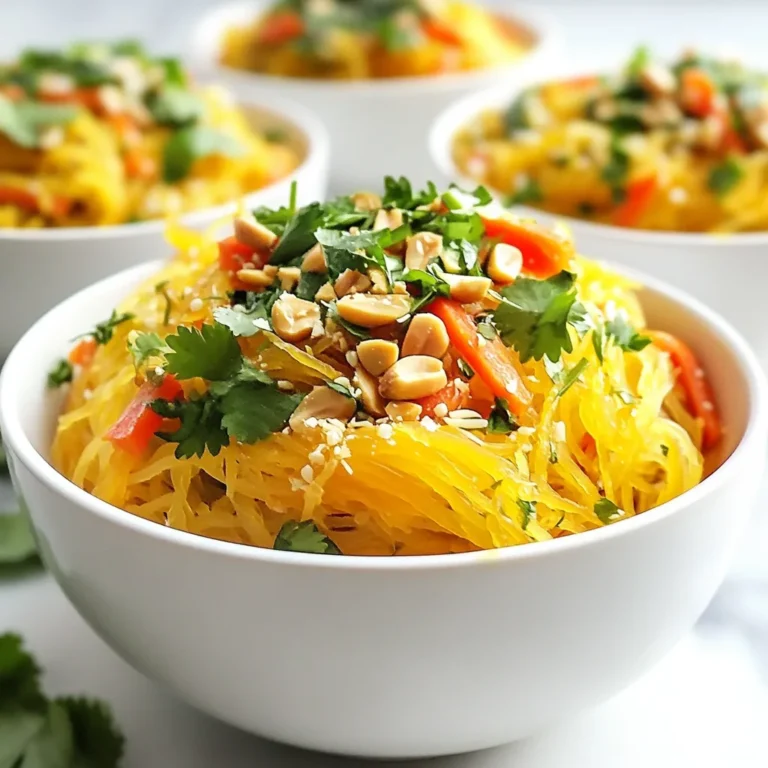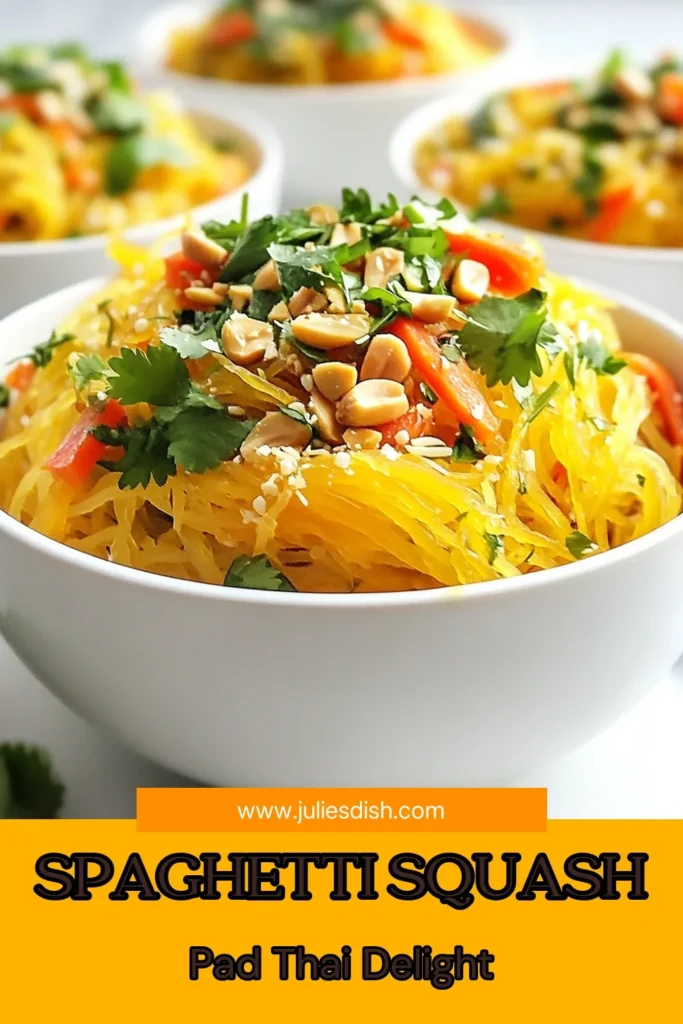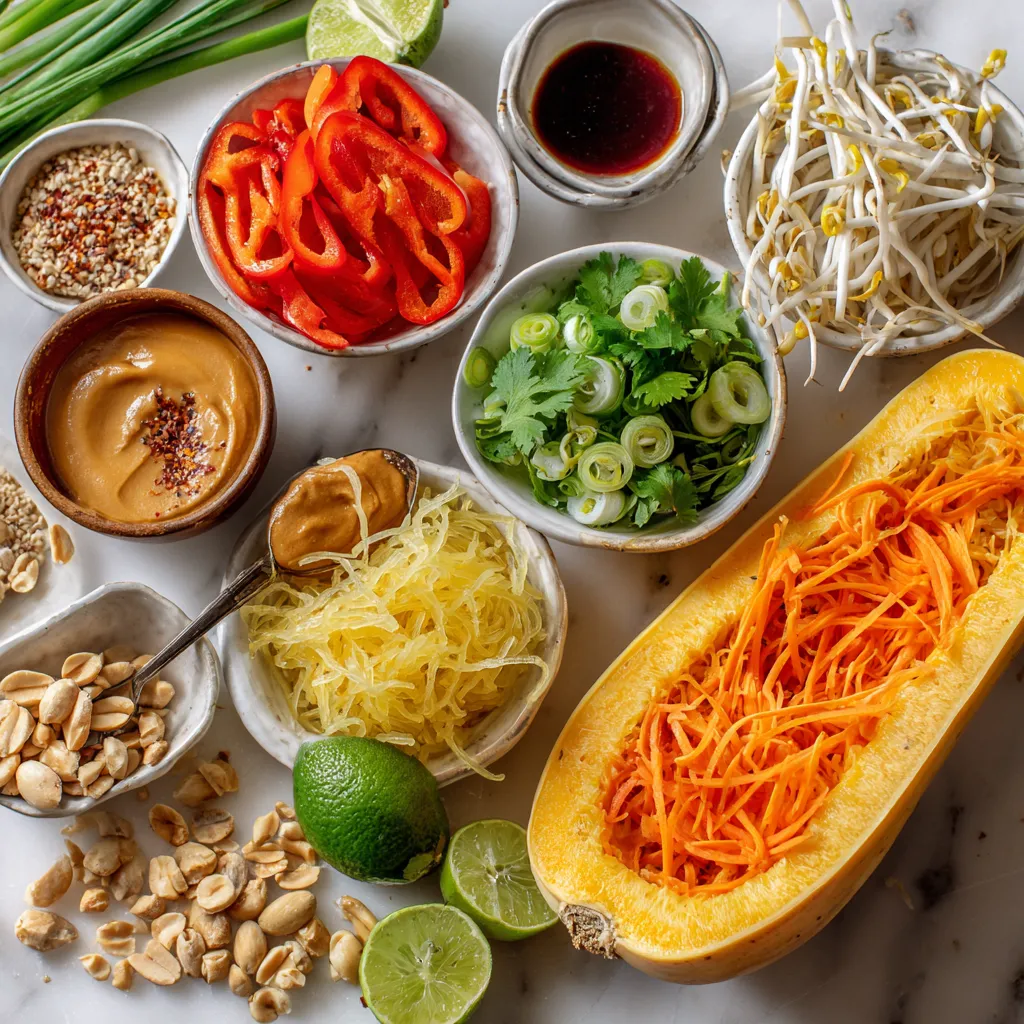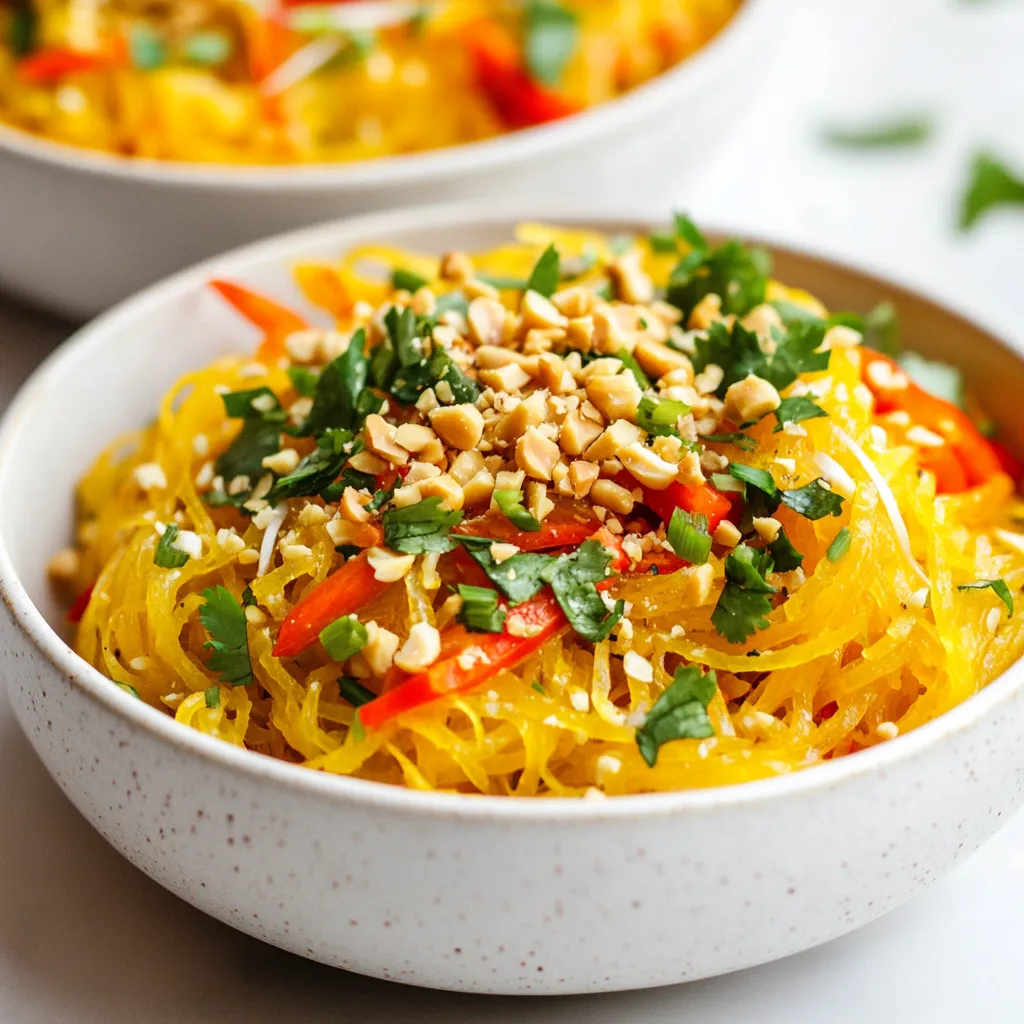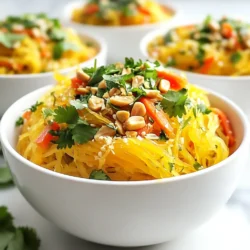WANT TO SAVE THIS RECIPE?
Craving a flavorful twist on a classic favorite? My Spaghetti Squash Pad Thai is the answer! This simple, tasty meal swaps out traditional noodles for healthy, roasted spaghetti squash. Packed with fresh veggies and a tasty sauce, it’s a delight for your taste buds. Whether you’re trying to eat healthier or just looking for a quick dinner, this recipe has you covered. Ready to impress? Let’s dive into the details!
Why I Love This Recipe
- Healthy Alternative: This recipe uses spaghetti squash instead of traditional noodles, making it a low-carb and nutrient-dense option.
- Flavorful Sauce: The combination of peanut butter, lime juice, and chili paste creates a rich and tangy sauce that elevates the dish.
- Quick and Easy: With a prep time of just 15 minutes, this dish is perfect for a quick weeknight dinner.
- Customizable: You can easily adjust the veggies and spice level to suit your preferences, making it versatile for everyone.
Ingredients
To make Spaghetti Squash Pad Thai, gather these fresh ingredients:
– Spaghetti squash
– Coconut oil
– Garlic
– Carrots
– Red bell pepper
– Green onions
– Bean sprouts
– Peanut butter
– Soy sauce or tamari
– Lime juice
– Maple syrup
– Chili paste
– Roasted peanuts
– Fresh cilantro
These ingredients bring bright flavors and great textures to your meal. Each one plays a key role in creating a delicious dish that is both healthy and satisfying.
Spaghetti squash serves as a fun and low-carb noodle option. The coconut oil adds a rich flavor, while garlic gives a nice aroma. Carrots and red bell pepper offer a crisp bite. Green onions and bean sprouts add freshness and crunch to the mix.
Peanut butter creates a creamy sauce that binds everything together. Soy sauce or tamari brings the salty umami flavor, and lime juice adds a zesty kick. Maple syrup sweetens the dish, and chili paste gives it a spicy touch. Finally, roasted peanuts and cilantro finish it off, adding crunch and a burst of freshness.
With these ingredients, you’ll create a delightful meal that is sure to impress!

Step-by-Step Instructions
Preparing the Spaghetti Squash
Start by preheating your oven to 400°F (200°C). Take your spaghetti squash and cut it in half lengthwise. Use a spoon to scoop out the seeds. Drizzle some coconut oil inside each half. Place the squash face down on a baking sheet with parchment paper. Roast it for about 30-40 minutes, until it feels tender. Once it’s cool, use a fork to scrape out the flesh into noodle-like strands.
Sautéing the Vegetables
In a large skillet or wok, heat 2 tablespoons of coconut oil over medium heat. Add 3 minced garlic cloves and cook for about 1 minute until you smell the nice aroma. Next, toss in 1 cup of julienned carrots and 1 sliced red bell pepper. Cook them for about 3-4 minutes until they start to soften.
Combining Ingredients and Making the Sauce
Now, add 2 chopped green onions and 1 cup of bean sprouts to the skillet. Stir-fry everything for another 2 minutes. In a small bowl, mix together 3 tablespoons of peanut butter, 2 tablespoons of soy sauce, 1 tablespoon of lime juice, 1 tablespoon of maple syrup, and 1 teaspoon of chili paste. Stir until it becomes smooth. If it’s too thick, add a bit of water to get the right consistency.
Final Toss and Serving
Add the spaghetti squash strands to the skillet with the veggies. Pour the sauce over everything and gently toss it all together. Make sure the squash and vegetables are well coated. Remove from heat and divide the Pad Thai into bowls. Top with chopped roasted peanuts and fresh cilantro. You can also add extra green onions for garnish if you like.
Tips & Tricks
Tips for Perfecting Your Pad Thai
Choosing the right spaghetti squash is key. Look for a squash that feels heavy with a smooth skin. A medium-sized one works best for this recipe.
Adjusting sauce consistency is also important. If the sauce feels thick, add a splash of water. This helps the flavors mix well and coat your squash nicely.
Cooking Techniques
Stir-frying tips make a big difference. Start with a hot pan to sear the veggies. This keeps them crisp and colorful. Don’t overcrowd the pan; cook in batches if needed.
Using the right pan matters too. A large skillet or wok helps heat evenly. This makes sure everything cooks at the same time.
Flavor Enhancements
Substitutions for key ingredients can change the taste. If you can’t find peanut butter, try almond or sunflower seed butter. Each gives a unique flavor while keeping it creamy.
Ingredients for extra heat or sweetness can enhance your dish. Add more chili paste for heat or extra maple syrup for sweetness. Fresh lime juice adds a nice zing too.
Pro Tips
- Choose the Right Squash: Look for a spaghetti squash that feels heavy for its size with a firm skin to ensure optimal flavor and texture.
- Adjust the Spice Level: If you prefer a milder dish, start with a small amount of chili paste and gradually add more to taste.
- Make Ahead: You can roast the spaghetti squash in advance and store it in the fridge. Just reheat before mixing with the sauce and vegetables.
- Garnish for Flavor: Fresh cilantro and lime wedges enhance the flavor of the dish, so don’t skip on those when serving!

Variations
Protein Additions
You can add many proteins to your Spaghetti Squash Pad Thai. Here are some great options:
– Tofu options: Use firm tofu for a nice texture. Press it to remove water, then cube it. Sauté the cubes until golden before adding them to the dish. This gives a nice crunch and holds the flavors well.
– Chicken or shrimp suggestions: If you prefer meat, chicken or shrimp works well. Cook sliced chicken breast or shrimp in the skillet before adding the veggies. Make sure they are cooked through for the best taste.
Vegan-Friendly Alternatives
Making this dish vegan is easy with these swaps:
– Dairy-free options for sauce: The sauce is already dairy-free with peanut butter. You can also use almond butter for a different flavor. Just ensure all other ingredients are vegan.
– Other vegetable additions: Feel free to add more veggies. Broccoli, snap peas, or zucchini can boost the dish. These add color and nutrients without changing the taste much.
Regional Variations of Pad Thai
Pad Thai can change based on where it is made. Here are some fun differences:
– Differences in flavor profiles: In Thailand, local Pad Thai may be sweeter or spicier. Each region has its twists. They might use tamarind paste or fish sauce for depth.
– Unique local ingredients: Some areas may add unique items, like pickled radish or different nuts. This adds unique flavors and textures to the dish.
Storage Info
Storing Leftovers
To keep your Spaghetti Squash Pad Thai fresh, place it in an airtight container. Store it in the fridge for up to four days. Before reheating, make sure to stir it well. This helps to mix the flavors back together. For reheating, use a microwave or a skillet. Heat gently to avoid overcooking the squash.
Freezing Options
You can freeze Spaghetti Squash Pad Thai for later use. Start by letting it cool completely. Then, place it in a freezer-safe container. It will keep well for up to three months. When you are ready to eat, take it out and thaw it in the fridge overnight. To reheat, use a skillet over low heat. Add a splash of water if it seems dry. Stir well to warm it evenly. Enjoy your delicious meal anytime!
FAQs
Common Questions about Spaghetti Squash Pad Thai
Can I use regular pasta instead of spaghetti squash?
Yes, you can. Regular pasta works well, but spaghetti squash is low-carb and unique. It adds a fun twist to the dish.
Is this dish gluten-free?
Yes! If you use tamari instead of soy sauce, it is gluten-free. Double-check the peanut butter too, just to be safe.
How do I make it spicier?
To add heat, increase the chili paste. You can also add sliced fresh chilies or red pepper flakes.
Nutritional Benefits of Spaghetti Squash
Low-carb vs. traditional noodles
Spaghetti squash is low in carbs compared to regular noodles. It has fewer calories, making it a great choice for lighter meals.
Vitamins and minerals in spaghetti squash
Spaghetti squash is rich in vitamins A and C. It also provides potassium and fiber, which are great for digestion.
Serving Suggestions
What to serve with Spaghetti Squash Pad Thai?
You can serve it with a side salad or fresh spring rolls. Both complement the flavors well.
Pairing drinks with the dish
I recommend iced tea or a light beer. They balance the flavors and keep the meal refreshing.
You now have a detailed guide to creating Spaghetti Squash Pad Thai. We covered the ingredients, step-by-step preparation, and tips for perfecting the dish. You also learned about tasty variations, storage options, and answers to common questions.
Try this healthy twist on Pad Thai and enjoy a flavorful meal. Remember, cooking is about experimenting and having fun. Enjoy your culinary adventure with Spaghetti Squash Pad Tha
Spaghetti Squash Pad Thai
A healthy twist on traditional Pad Thai using spaghetti squash instead of noodles.
Prep Time 15 minutes mins
Cook Time 40 minutes mins
Total Time 55 minutes mins
Course Main Course
Cuisine Thai
Servings 4
Calories 350 kcal
- 1 medium spaghetti squash
- 2 tablespoons coconut oil
- 3 cloves garlic, minced
- 1 cup carrots, julienned
- 1 red bell pepper sliced
- 2 green onions chopped (plus extra for garnish)
- 1 cup bean sprouts
- 3 tablespoons peanut butter
- 2 tablespoons soy sauce (or tamari for gluten-free)
- 1 tablespoon lime juice
- 1 tablespoon maple syrup
- 1 teaspoon chili paste (adjust for heat preference)
- 0.25 cup roasted peanuts, chopped
- 1 bunch fresh cilantro for garnish
Prepare the Spaghetti Squash: Begin by preheating your oven to 400°F (200°C). Cut the spaghetti squash in half lengthwise and scoop out the seeds. Drizzle the insides with a bit of coconut oil, then place the squash halves face down on a baking sheet lined with parchment paper. Roast for about 30–40 minutes, or until tender. Once done, let it cool slightly before using a fork to scrape out the flesh into noodle-like strands.
Sauté the Vegetables: In a large skillet or wok, heat the coconut oil over medium heat. Add minced garlic and sauté for about 1 minute, or until fragrant. Toss in the julienned carrots and sliced red bell pepper, cooking for 3–4 minutes until they begin to soften.
Combine Ingredients: Add the green onions and bean sprouts into the skillet, continuing to stir-fry for another 2 minutes.
Make the Sauce: In a small bowl, mix the peanut butter, soy sauce, lime juice, maple syrup, and chili paste until smooth. If the mixture is too thick, add a splash of water to reach your desired consistency.
Toss Everything Together: Add the spaghetti squash strands directly to the skillet with the sautéed vegetables. Pour the sauce over the top and gently toss everything together, ensuring the squash and vegetables are well coated in the sauce.
Serve: Remove from heat, divide the Pad Thai into serving bowls, and top with chopped roasted peanuts and fresh cilantro. Garnish with additional green onions if desired.
Adjust the chili paste for desired heat level.
Keyword gluten-free, healthy, pad thai, spaghetti squash
WANT TO SAVE THIS RECIPE?
